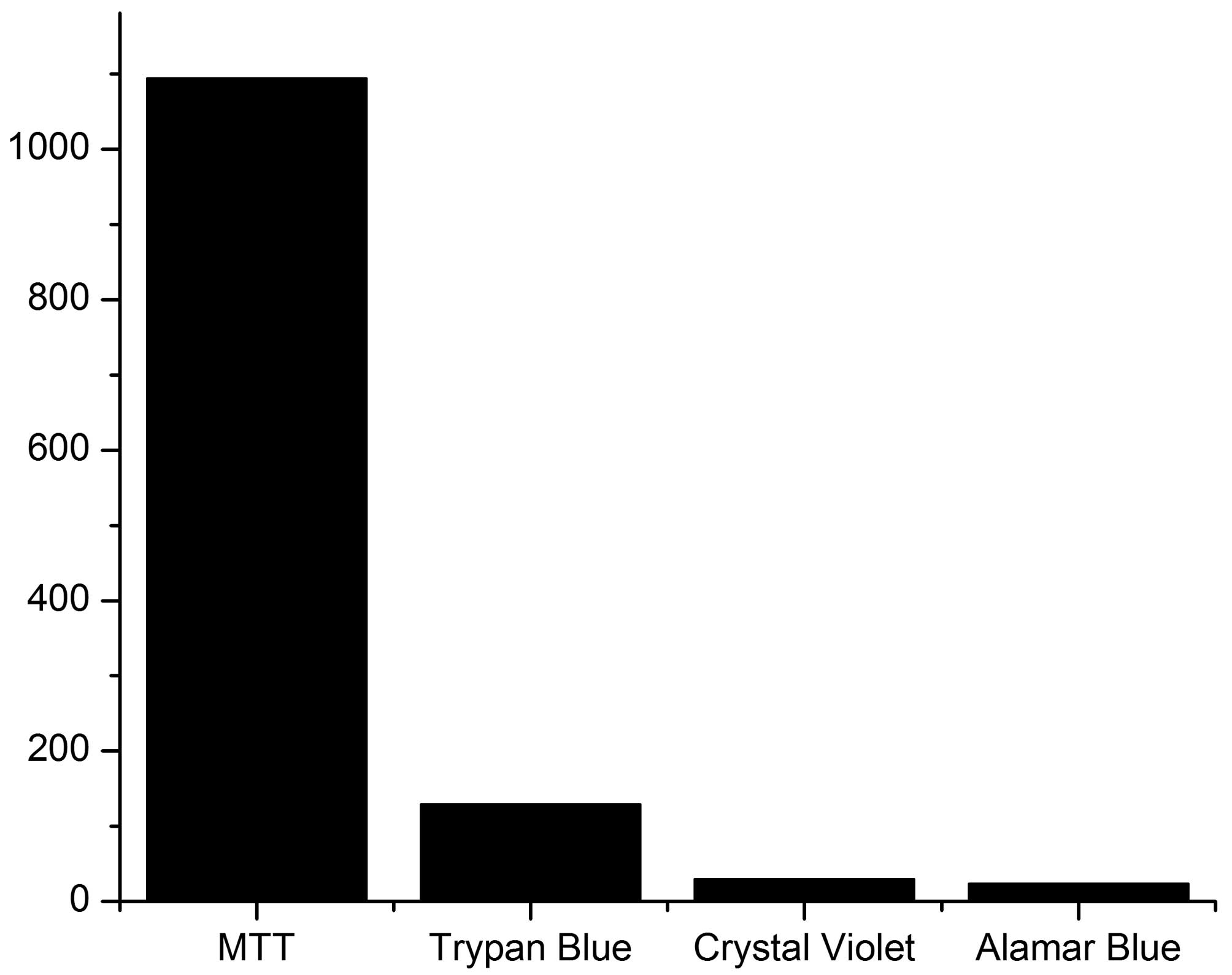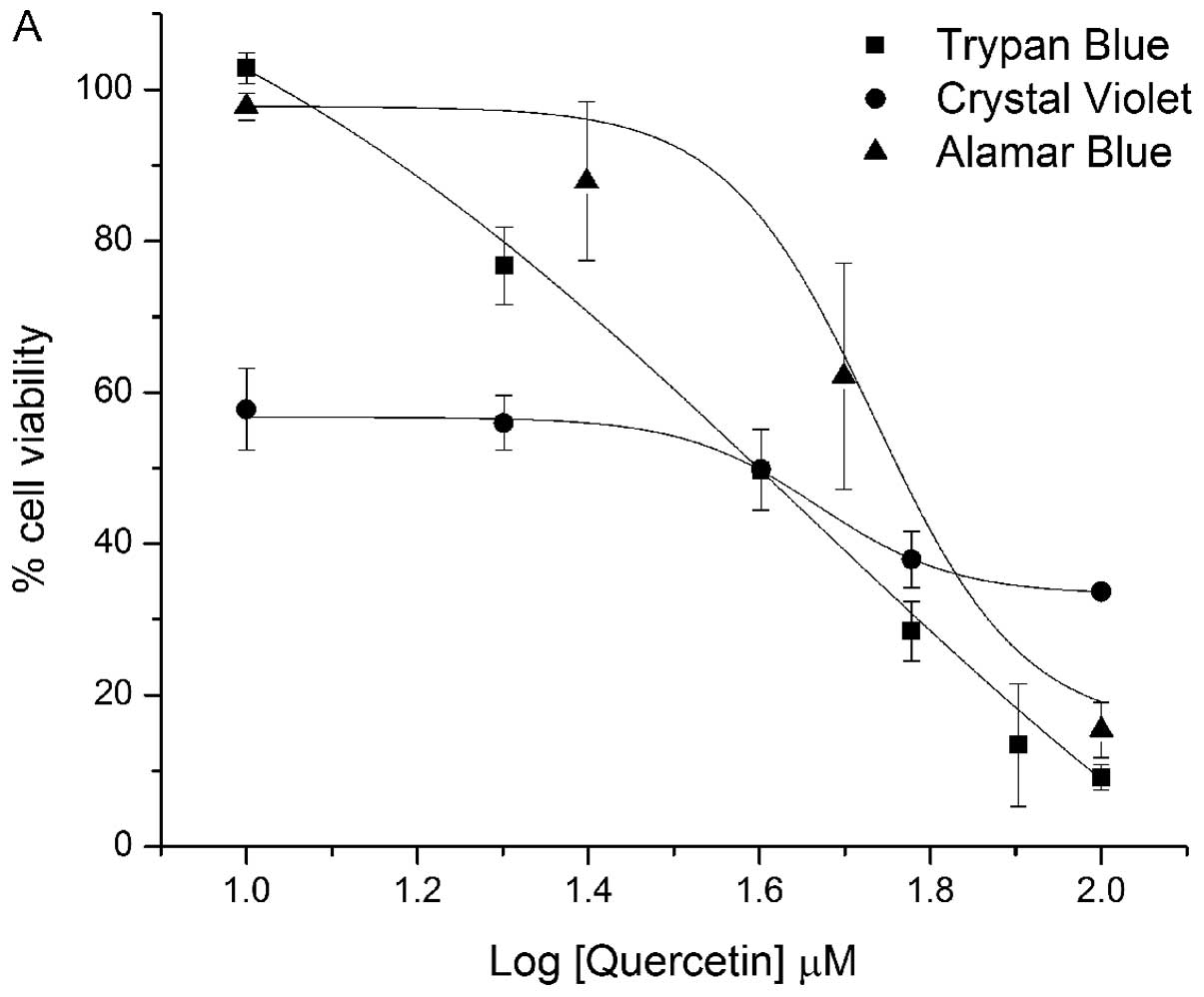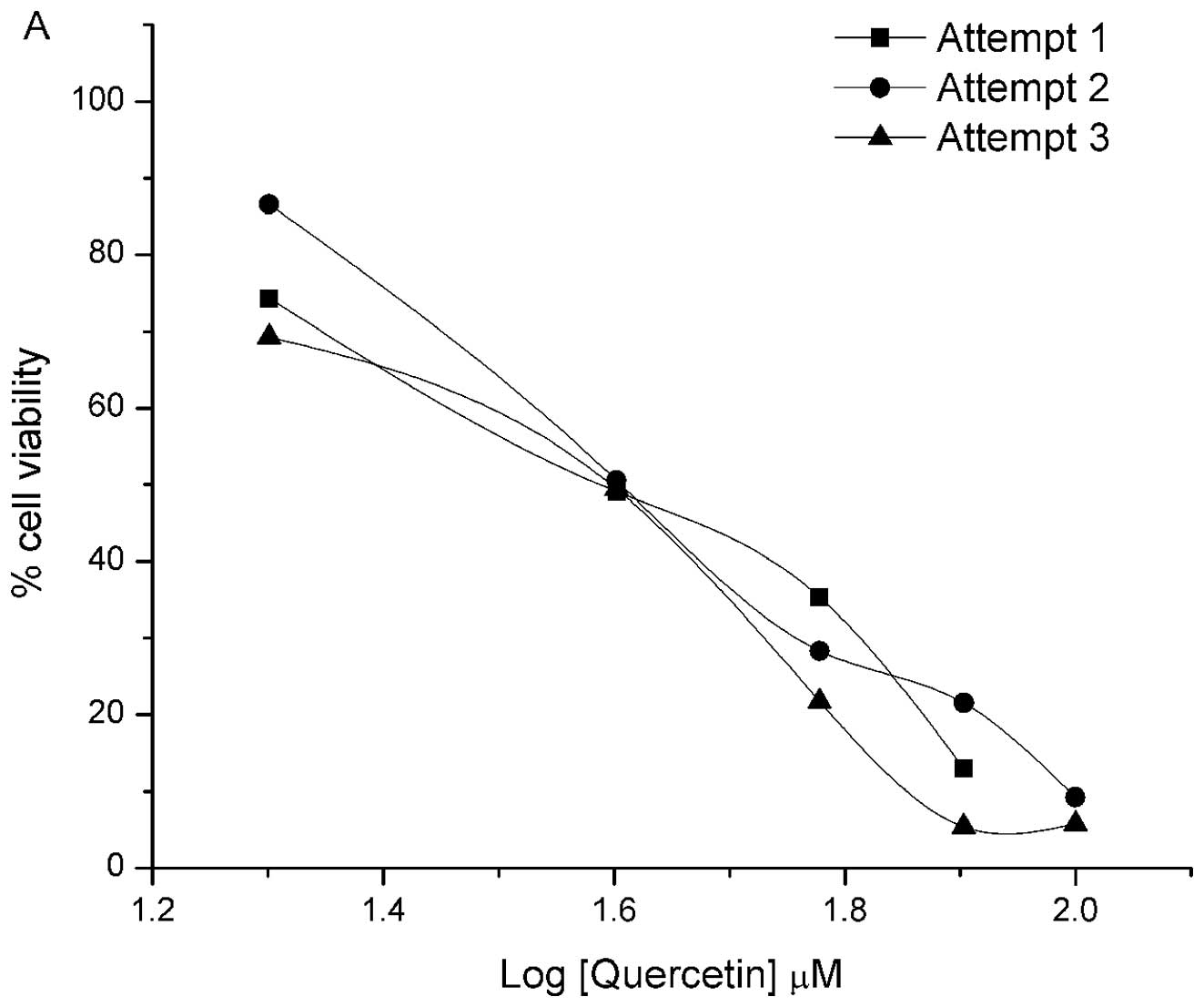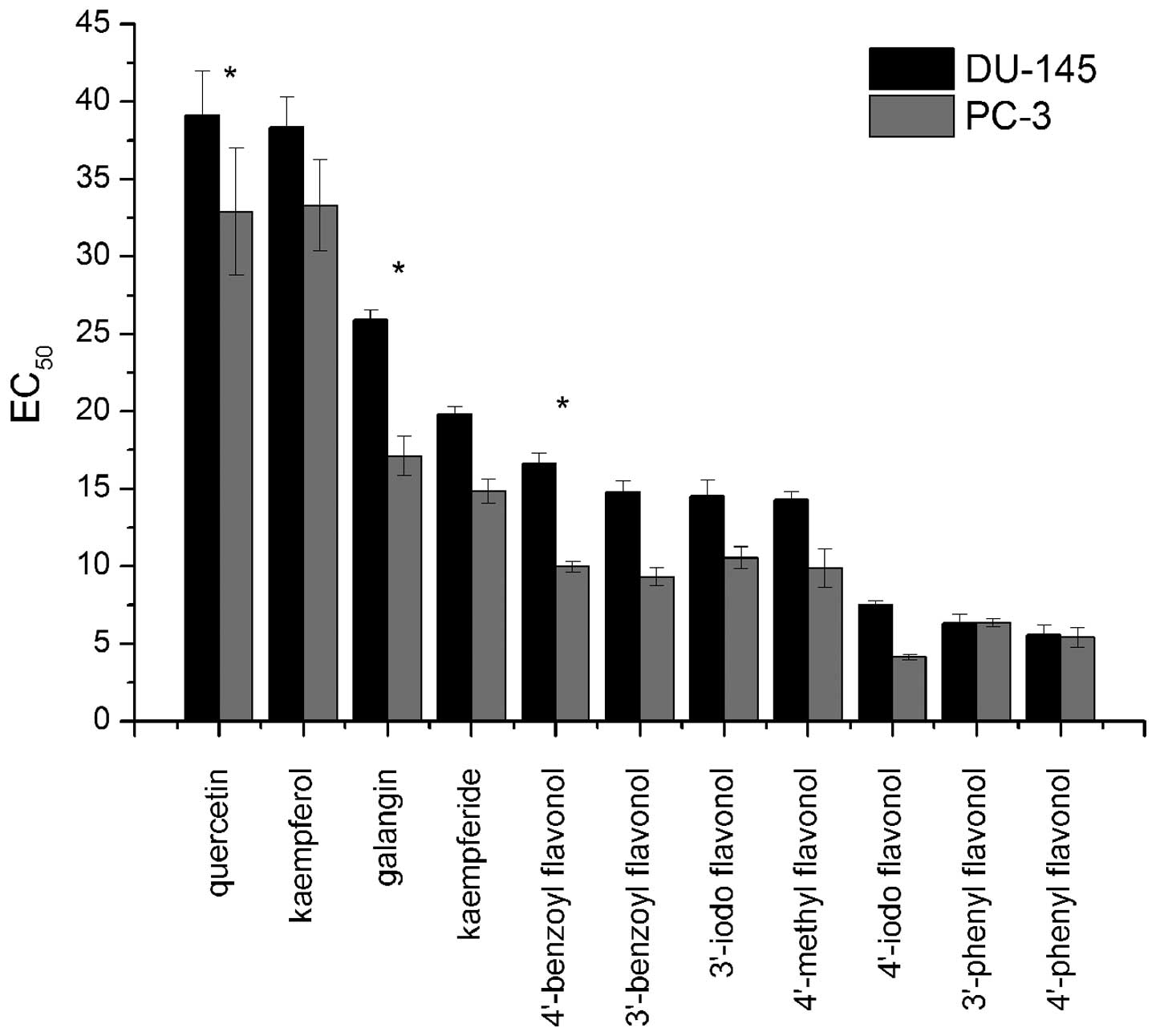Synthesis and anticancer activity of new flavonoid analogs and inconsistencies in assays related to proliferation and viability measurements
- Authors:
- Alaina M. Forbes
- Huimin Lin
- Gary G. Meadows
- G. Patrick Meier
-
Affiliations: Department of Chemistry, Washington State University, Pullman, WA 99164-4630, USA, Department of Pharmaceutical Sciences, Washington State University, Pullman, WA 99164-4630, USA - Published online on: May 21, 2014 https://doi.org/10.3892/ijo.2014.2452
- Pages: 831-842
This article is mentioned in:
Abstract
 |
 |
 |
 |
|
Dorta DJ, Curti C and Rodrigues T: Effects of flavonoids on mitochondria: An overview on pharmacological and toxicological aspects. Mitochondrial Pharmacology and Toxicology. Moreno AJM, Oliveira PJ and Palmeira CM: Transworld Research Network; Kerala, India: pp. 147–161. 2006 | |
|
Agullo G, Gamet-Payrastre L, Manenti S, Viala C, Remesy C, Chap H and Payrastre B: Relationship between flavonoid structure and inhibition of phosphatidylinositol 3-kinase: A comparison with tyrosine kinase and protein kinase C inhibition. Biochem Pharmacol. 53:1649–1657. 1997. View Article : Google Scholar : PubMed/NCBI | |
|
Haddad AQ, Venkateswaran V, Viswanathan L, Teahan SJ, Fleshner NE and Klotz LH: Novel antiproliferative flavonoids induce cell cycle arrest in human prostate cancer cell lines. Prostate Cancer Prostatic Dis. 9:68–76. 2006. View Article : Google Scholar : PubMed/NCBI | |
|
Nair HK, Rao KV, Aalinkeel R, Mahajan S, Chawda R and Schwartz SA: Inhibition of prostate cancer cell colony formation by flavonoid quercetin correlates with modulation of specific regulatory genes. Clin Diagn Lab Immunol. 11:63–69. 2004.PubMed/NCBI | |
|
Mokhtari MJ, Motamed N and Shokrgozar MA: Evaluation of silibinin on the viability, migration, and adhesion of the human prostate adenocarcinoma (PC-3) cell line. Cell Bio Int. 32:888–892. 2008. View Article : Google Scholar : PubMed/NCBI | |
|
Daskiewicz JB, Depeint F, Viornery L, et al: Effects of flavonoids on cell proliferation and caspase activation in human colonic cell line HT29: an SAR study. J Med Chem. 48:2790–2804. 2005. View Article : Google Scholar : PubMed/NCBI | |
|
Knowles LM, Zigrossi DA, Tauber RA, Hightower C and Milner JA: Flavonoids suppress androgen-independent human prostate tumor proliferation. Nutr Cancer. 38:116–122. 2000. View Article : Google Scholar : PubMed/NCBI | |
|
Skibola CF and Smith MT: Potential health impacts of excessive flavonoid intake. Free Radic Biol Med. 29:375–383. 2000. View Article : Google Scholar : PubMed/NCBI | |
|
MacGregor JT and Jurd L: Mutagenicity of plant flavonoids: structural requirements for mutagenic activity in Salmonella typhimurium. Mutat Res. 54:297–309. 1978. View Article : Google Scholar : PubMed/NCBI | |
|
Carver JH, Carrano AV and MacGregor JT: Genetic effects of the flavonols quercetin, kaempferol, and galangin on Chinese hamster ovary cells in vitro. Mutat Res. 113:45–60. 1983. View Article : Google Scholar : PubMed/NCBI | |
|
Bjeldanes LF and Chang GW: Mutagenic activity of quercetin and related compounds. Science. 197:577–578. 1977. View Article : Google Scholar : PubMed/NCBI | |
|
Brown JP and Dietrich PS: Mutagenicity of plant flavonols in Salmonella/mammalian microsome test: activation of flavonol glycosides by mixed glycosidases from rat cecal bacteria and other sources. Mutat Res. 66:223–240. 1979.PubMed/NCBI | |
|
Hillard JJ, Krause HM, Brenstein JI, Fernandez JA, Nguyen V, Ohemeng KA and Barrett JF: A comparison of active binding of 4-quinolones and novel flavone gyrase inhibitors to DNA gyrase. Adv Exp Med Biol. 390:59–69. 1995.PubMed/NCBI | |
|
Guthrie N and Manthey JA: Antiproliferative activities of citrus flavonoids against six human cancer cell lines. J Agric Food Chem. 50:5837–5843. 2002. View Article : Google Scholar : PubMed/NCBI | |
|
García-Mediavilla V, Crespo I, Collado PS, Esteller A, Sánchez-Campos S, Tuñón MJ and González-Gallego J: The anti-inflammatory flavones quercetin and kaempferol cause inhibition of inducible nitric oxide synthase, cyclooxygenase-2, and reactive C-protein, and down-regulation of the nuclear factor kappaB pathway in Chang Liver cells. Eur J Pharmacol. 557:221–229. 2007. | |
|
Kaushik D, O’Fallon K, Clarkson PM, Dunne CP, Conca KR and Michniak-Kohn B: Comparison of quercetin pharmacokinetics following oral supplementation in humans. J Food Sci. 77:H231–H238. 2012. View Article : Google Scholar : PubMed/NCBI | |
|
Suomela JP, Ahotupa M, Yang B, Vasankari T and Kallio H: Adsorption of flavonols derived from sea buckthorn (Hippophae rhamnoides L.) and their effects on emerging risk factors for cardiovascular disease in humans. J Agric Food Chem. 54:7364–7369. 2006.PubMed/NCBI | |
|
Manach C, Williamson G, Morand C, Scalbert A and Rémésy C: Bioavailability and bioefficacy of polyphenols in humans. I. Review of 97 bioavailability studies. Am J Clin Nutr. 81(Suppl 1): S230–S242. 2005.PubMed/NCBI | |
|
Del Rio DD, Borges G and Crozier A: Berry flavonoids and phenolics: bioavailability and evidence of protective effects. Br J Nutr. 104(Suppl 3): S67–S90. 2010.PubMed/NCBI | |
|
Gao S and Hu M: Bioavailability challenges associated with development of anti-cancer phenolics. Mini Rev Med Chem. 10:550–567. 2010. View Article : Google Scholar : PubMed/NCBI | |
|
Singh B, Mense SM, Bhat NK, Putty S, Guthiel WA, Remotti F and Bhat HK: Dietary quercetin exacerbates the development of estrogen-induced breast tumors in female ACI rats. Toxicol Appl Pharmacol. 247:83–90. 2010. View Article : Google Scholar : PubMed/NCBI | |
|
Yadegarynia S, Pham A, Ng A, et al: Profiling flavonoid cytotoxicity in human breast cancer cell lines: determination of structure-function relationships. Nat Prod Commun. 7:1295–1304. 2012.PubMed/NCBI | |
|
Chang H, Mi M, Ling W, et al: Structurally related cytotoxic effects of flavonoids on human cancer cells in vitro. Arch Pharm Res. 31:1137–1144. 2008. View Article : Google Scholar : PubMed/NCBI | |
|
Li X, Wang X, Ye H, Peng A and Chen L: Barbigerone, an isoflavone, inhibits tumor angiogenesis and human non-small-cell lung cancer xenografts growth through VEGFR2 signaling pathways. Cancer Chemother Pharmacol. 70:425–437. 2012. View Article : Google Scholar : PubMed/NCBI | |
|
Wu TC, Yang YC, Huang PR, Wen YD and Yeh SL: Genistein enhances the effect of trichostatin A on inhibition of A549 cell growth by increasing expression of TNF receptor-1. Toxicol Appl Pharmacol. 262:247–254. 2012. View Article : Google Scholar : PubMed/NCBI | |
|
Wesolowska O, Wiśniewski J, Sroda-Pomianek K, et al: Multidrug resistance reversal and apoptosis induction in human colon cancer cells by some flavonoids present in citrus plants. J Nat Prod. 75:1896–1902. 2012. View Article : Google Scholar : PubMed/NCBI | |
|
Vaid M, Prasad R, Singh T, Jones V and Katiyar SK: Grape seed proanthocyanidins reactivate silenced tumor suppressor genes in human skin cancer cells by targeting epigenetic regulators. Toxicol Appl Pharmacol. 263:122–130. 2012. View Article : Google Scholar : PubMed/NCBI | |
|
Lee DH, Szczepanski M and Lee YJ: Role of Bax in quercetin-induced apoptosis in human prostate cancer cells. Biochem Pharmacol. 75:2345–2355. 2008. View Article : Google Scholar : PubMed/NCBI | |
|
Gamet-Payrastre L, Manenti S, Gratacap MP, Tulliez J, Chap H and Payrastre B: Flavonoids and the inhibition of PKC and PI 3-Kinase. Gen Pharmacol. 32:279–286. 1999. View Article : Google Scholar : PubMed/NCBI | |
|
Lee LT, Huang YT, Hwang JJ, et al: Transinactivation of the epidermal growth factor receptor tyrosine kinase and focal adhesion kinase phosphorylation by dietary flavonoids; effect on invasive potential of human carcinoma cells. Biochem Pharmacol. 67:2103–2114. 2004. View Article : Google Scholar | |
|
Di Pietro A, Conseil G, Perez-Victoria JM, et al: Modulation by flavonoids of cell multidrug resistance mediated by P-glycoprotein and related ABC transporters. Cell Mol Life Sci. 59:307–322. 2002.PubMed/NCBI | |
|
Politzer P, Lane P, Concha MC, Ma Y and Murray JS: An overview of halogen bonding. J Mol Model. 13:305–311. 2007. View Article : Google Scholar : PubMed/NCBI | |
|
Bruggisser R, von Daeniken K, Jundt G, Schaffner W and Tullberg-Reinert H: Interference of plant extracts, phytoestrogens, and antioxidants with MTT tetrazolium assay. Planta Med. 68:445–448. 2002. View Article : Google Scholar : PubMed/NCBI | |
|
Molander GA and Biolatto B: Palladium-catalyzed Suzuki-Miyaura cross-coupling reactions of potassium aryl- and heteroaryltrifluoroborates. J Org Chem. 68:4302–4314. 2003. View Article : Google Scholar : PubMed/NCBI | |
|
Khan N, Afaq F, Syed DN and Mukhtar H: Fisetin, a novel dietary flavonoid, causes apoptosis and cell cycle arrest in human prostate cancer LNCaP cells. Carcinogenesis. 29:1049–1056. 2008. View Article : Google Scholar : PubMed/NCBI | |
|
Harborne JB, Grayer RF, Porter LF, et al: The Flavonoids Advances in Research Since 1980. Harborne, New York: pp. 399–420. 1988 | |
|
Tanaka H, Stohlmeyer MM, Wandless TJ and Taylor LP: Synthesis of flavonol derivatives as probes of biological processes. Tetrahedron Lett. 41:9735–9739. 2000. View Article : Google Scholar | |
|
Ichikawa M, Pamukcu AM and Bryan GT: A convenient method for the synthesis of kaempferol. Org Prep Proced Int. 14:183–187. 1982. View Article : Google Scholar | |
|
Urgaonkar S and Shaw JT: Synthesis of kaempferitrin. J Org Chem. 72:4582–4585. 2007. View Article : Google Scholar : PubMed/NCBI | |
|
Landini D, Montanari F and Rolla F: Cleavage of dialkyl and aryl alkyl ethers with hydrobromic acid in the presence of phase-transfer catalysts. Synthesis. 10:771–773. 1978. View Article : Google Scholar | |
|
Boumendjel A, Bois F, Beney C, Mariotte AM, Conseil G and Di Pietro A: B-ring substituted 5,7-dihydroxyflavonols with high-affinity binding to P-glycoprotein responsible for cell multidrug resistance. Bioorg Med Chem Let. 11:75–77. 2001. View Article : Google Scholar : PubMed/NCBI | |
|
Azimova SS and Vinogradova VIG: Galangin. Natural Compounds: Flavonoids: Plant Sources, Structure and Properties. Springer; New York: pp. 962013 | |
|
Batirov EK, Kiyamitdinova F and Malikov VM: Flavonoids of the epigeal part of Glycyrrhiza glabra. Chem Nat Compd. 22:107–108. 1986. View Article : Google Scholar | |
|
Yuldashev MP: Flavonoids of the epigeal part of Glycyrrhiza uralensis. Chem Nat Compd. 34:508–509. 1998. View Article : Google Scholar | |
|
Agrawal PK and Rastogi RP: 13C NMR spectroscopy of flavonoids. Heterocycles. 16:21811981. View Article : Google Scholar | |
|
Xu R, Zhang Y, Ye X, Xue S, Shi J, Pan J and Chen Q: Inhibition effects and induction of apoptosis of flavonoids on the prostate cancer cell line PC-3 in vitro. Food Chem. 138:48–53. 2013. View Article : Google Scholar : PubMed/NCBI | |
|
Torkin R, Lavoie JF, Kaplan DR and Yeger H: Induction of caspase-dependent, p53-mediated apoptosis by apigenin in human neuroblastoma. Mol Cancer Ther. 4:1–11. 2005. View Article : Google Scholar : PubMed/NCBI | |
|
Ferguson PJ, Kurowska E, Freeman DJ, Chambers AF and Koropatnick DJ: A flavonoid fraction from cranberry extract inhibits proliferation of human tumor cell lines. J Nutr. 134:1529–1535. 2004.PubMed/NCBI | |
|
Walle T, Ta N, Kawamori T, Wen X, Tsuji PA and Walle UK: Cancer chemopreventive properties of orally bioavailable flavonoids - methylated versus unmethylated flavones. Biochem Pharmacol. 73:1288–1296. 2007. View Article : Google Scholar | |
|
Gosslau A, Chen M, Ho CT and Chen KY: A methoxy derivative of resveratrol analogue selectively induced activation of the mitochondrial apoptotic pathway in transformed fibroblast. Br J Cancer. 92:513–521. 2005. | |
|
Berridge MV and Tan AS: Characterization of the cellular reduction of 3-(4,5-dimethylthiazol-2-yl)-2,5-diphenyltetrazolium bromide (MTT): subcellular localization, substrate dependence, and involvement of mitochondrial electron transport in MTT reduction. Arch Biochem Biophys. 303:474–482. 1993. View Article : Google Scholar | |
|
Dunigan DD, Waters SB and Owen TC: Aqueous soluble tetrazolium/formazan MTS as an indicator of NADH- and NADPH-dependent dehydrogenase activity. Biotechniques. 19:640–649. 1995.PubMed/NCBI | |
|
Maeda H, Matsu-Ura S, Yamauchi Y and Ohmori H: Resaurin as an electron acceptor in glucose oxidase-catalyzed oxidation of glucose. Chem Pharm Bull. 49:622–625. 2001. View Article : Google Scholar : PubMed/NCBI | |
|
Suszynski TM, Wildey GM, Falde EJ, et al: The ATP/DNA ratio is a better indicator of islet cell viability than the ADP/ATP ratio. Transplant Proc. 40:346–350. 2008. View Article : Google Scholar : PubMed/NCBI | |
|
Wisman KN, Perkins AA, Jeffers MD and Hagerman AE: Accurate assessment of the bioactivities of redox-active polyphenolics in cell culture. J Agric Food Chem. 56:7831–7837. 2008. View Article : Google Scholar : PubMed/NCBI | |
|
Maioli E, Torricelli C, Fortino V, Carlucci F, Tommassini V and Pacini A: Critical appraisal of the MTT assay in the presence of rottlerin and uncouplers. Biol Proced Online. 11:227–240. 2009. View Article : Google Scholar : PubMed/NCBI | |
|
Wang P, Henning SM and Heber D: Limitations of MTT and MTS-based assays for measurement of antiproliferative activity of green tea polyphenols. PLoS One. 5:e102022010. View Article : Google Scholar : PubMed/NCBI | |
|
Zhang D, Liu Y, Chu L, et al: Relationship between the structures of flavonoids and oxygen radical absorbance capacity values: a quantum chemical analysis. J Phys Chem A. 117:1784–1794. 2013. View Article : Google Scholar : PubMed/NCBI | |
|
Pourcel L, Routaboul JM, Cheynier V, Lepiniec L and Debeaujon I: Flavonoid oxidation in plants: from biochemical properties to physiological functions. Trends Plant Sci. 12:29–36. 2007. View Article : Google Scholar : PubMed/NCBI | |
|
Jacobs H, Moalin M, Bast A, van der Vijgh WJ and Haenen GR: An essential difference between the flavonoids monoHER and quercetin in their interplay with the endogenous antioxidant network. PLoS One. 5:e138802010. View Article : Google Scholar : PubMed/NCBI | |
|
Wang S, Yu H and Wickliffe JK: Limitations of the MTT and XTT assays for measuring cell viability due to superoxide formation induced by nano-scale TiO2. Toxicol In Vitro. 25:2147–2151. 2011. View Article : Google Scholar : PubMed/NCBI | |
|
Stockert JC, Blázquez-Castro A, Cañete M, Horobin RW and Villanueva A: MTT assay for cell viability: Intracellular localization of the formazan product is in lipid droplets. Acta Histochem. 114:785–796. 2012. View Article : Google Scholar : PubMed/NCBI | |
|
Tranzer JP and Pearse AG: Cytochemical demonstration of ubiquinones in animal tissues. Nature. 199:1063–1066. 1963. View Article : Google Scholar : PubMed/NCBI | |
|
Carmichael J, DeGraff WG, Gazdar AF, Minna JD and Mitchell JB: Evaluation of a tetrazolium-based semiautomated colorimetric assay: assessment of chemosensitivity testing. Cancer Res. 47:936–942. 1987.PubMed/NCBI | |
|
Shapiro AB and Ling V: Positively cooperative sites for drug transport by P-glycoprotein with distinct drug specificities. Eur J Biochem. 250:130–137. 1997. View Article : Google Scholar : PubMed/NCBI | |
|
Bennett MD, Price HJ and Johnston JS: Anthocyanin inhibits propidium iodide DNA fluorescence in Euphorbia pulcherrima: implications for genome size variation and flow cytometry. Ann Bot. 101:777–790. 2008. View Article : Google Scholar : PubMed/NCBI | |
|
Tajmir-Riahi HA, Diamantoglou S, Kanakis CD, Tarantilis PA and Polissiou MG: Flavonoids interactions with DNA and RNA: binding modes and antioxidative effects. Acta Hort. 744:195–204. 2007. | |
|
Baracca A, Sqarbi G, Solaini G and Lenaz G: Rhodamine 123 as a probe of mitochondrial membrane potential: evaluation of proton flux through F(0) during ATP synthesis. Biochim Biophys Acta. 1606:137–146. 2003. View Article : Google Scholar : PubMed/NCBI | |
|
Shapiro AB and Ling V: Effect of quercetin on Hoechst 33342 transport by purified and reconstituted P-glycoprotein. Biochem Pharmacol. 53:587–596. 1997. View Article : Google Scholar : PubMed/NCBI | |
|
Liu Y, Peterson DA, Kimura H and Schubert D: Mechanism of cellular 3-(4,5-dimethylthiazol-2-yl)-2,5-diphenyltetrazolium bromide (MTT) reduction. J Neurochem. 69:581–593. 1997. View Article : Google Scholar | |
|
Altman SA, Randers L and Rao G: Comparison of trypan blue dye exclusion and fluorometric assays for mammalian cell viability determinations. Biotechnol Prog. 9:671–674. 1993. View Article : Google Scholar : PubMed/NCBI | |
|
Smith AL and Smith HV: A comparison of fluorescein diacetate and propidium iodide staining and in vitro excystation for determining Giardia intestinalis cyst viability. Parasitology. 99:329–331. 1989. View Article : Google Scholar : PubMed/NCBI | |
|
Mascotti K, McCullough J and Burger SR: HPC viability measurement: trypan blue versus acridine orange and propidium iodide. Transfusion. 40:693–696. 2000. View Article : Google Scholar : PubMed/NCBI | |
|
Szabo SE, Monroe SL, Fiorino S, Bitzan J and Loper K: Evaluation of an automated instrument for viability and concentration measurements of cryopreserved hemapoietic cells. Lab Hematol. 10:109–111. 2004. View Article : Google Scholar : PubMed/NCBI | |
|
Vijayababu MR, Arunkumar A, Kanagaraj P, Venkataraman P, Krishnamoorthy G and Arunakaran J: Quercetin downregulates matrix metalloproteinases 2 and 9 proteins in prostate cancer (PC-3). Mol Cell Biochem. 287:109–116. 2006. View Article : Google Scholar : PubMed/NCBI | |
|
Hollman PC and Katan MB: Absorption, metabolism and health effects of dietary flavonoids in man. Biomed Pharmacother. 51:305–310. 1997. View Article : Google Scholar : PubMed/NCBI | |
|
Hollman PC, van Trijp JM, Mengelers MJ, de Vries JH and Katan MB: Bioavailability of the dietary antioxidant flavonol quercetin in man. Cancer Lett. 114:139–140. 1997. View Article : Google Scholar : PubMed/NCBI | |
|
Hollman PC, van Trijp JM, Buysman MN, van der Gaag MS, Mengelers MJ, de Vries JH and Katan MB: Relative bioavailability of the antioxidant flavonoid quercetin from various foods in man. FEBS Lett. 418:152–156. 1997. View Article : Google Scholar : PubMed/NCBI |










